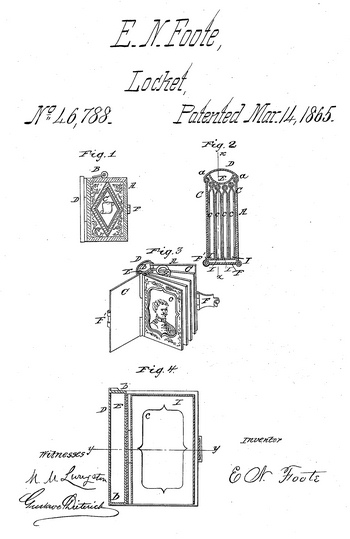Edward Newton Foote
- Born: 27 Mar 1833, Chester, Hampshire, MA
- Died: 14 Oct 1912, Northampton MA
General notes:
Jeweler
Events in his life were:

- He was issued design patent number 46,788 on 14 Mar 1865
E. N. FOOTE, OF NEW ENGLAND VILLAGE, MASSACHUSETTS.
MINIATURE LOCKET.
Specification forming part of Letters Patent No. 46,788, dated March 14, 1865.
To all whom it may concern:
Be it known that I, E. N. FOOTE, of New England Village, in the county of Worcester and State of Massachusetts, have invented a new and useful Improvement in Photographic Lockets; and I do hereby declare that the following is a full, clear, and exact description thereof, which will enable others skilled in the art to make and use the same,reference being had to the accompanying drawings, forming part of this specification, in which—
Figure 1 is an elevation of a locket made according to my invention. Fig. 2 is an elevation of a transverse section, taken on the line y of Fig. 4. Fig. 3 is an elevation of the locket, showing it open. Fig. 4 is an elevation of a longitudinal section, taken on the line x of Fig. 2.
Similar letters of reference indicate like parts.
This invention consists in a new ornament— to wit, a locket wherein is produce I in miniature an imitation of a photographic album, with spaces for photographic and other pictures, the leaves or receptacles for the pictures and the outer sides of the locket being so attached to the body thereof as to be capable of opening wide to expose the picture to view.
A is the locket ready to be worn, suspended to a chain from a ring, B, or a catch of any kind, which ring B is here shown connected to the upper edge of one of the leaves I. The locket is composed substantially of several leaves I, covers CC, a hollow back, the crosssection of which resembles a lens of unequal convexity, the side of the least convexity, D, being the outer side of the back, and the side of greatest convexity-being the inner side of the back. The edges of the outer side, D, moreover, extend beyond the lines of intersection of the parts D E, as shown in Fig. 2 at a a1. The convex plates D E are united by soldering or brazing, and the hollow space between them is closed at either end by plates b b according to the art of the goldsmith. G G are covers, which are hinged to the concave face of the convex plate I) beneath the edges a a, and in such a way as to enable the said covers to be moved when they are opened through an arc of about ninety degrees, so as fully to expose the adjacent leaf I. The leaves I may be more or less numerous, according to the thinness of the leaves and the size of the curved plate E. They are made with double walls open below, after the manner of the leaves of photographic albums, and cut away in the center of their areas, as at c, to expose the pictures secured between the double walls thereof. The said leaves are hinged separately to the back of the locket in lines parallel with the hinges of the covers, and are unequal in breadth, according to the position they severally occupy on the convexity of the plate E, so that when the leaves are closed their front edges shall be in the same plane as represented in Fig. 2.
F is a spring-clasp, hinged to the front edge of one of the covers C, which takes hold of a keeper, F', on the front edge of the other cover, by means of which the locket is locked. The position of the hinges of the several leaves at different elevations of the convexity of the curved plate E enables one to move each leaf when it is being opened through an arc equal or nearly equal to that described by the respective covers C, so that the several leaves when opened to their full extent stand nearly at right-angles to the adjacent unopened leaf, thereby fully exposing the several pictures successively as the leaves are opened.
The leaves I are to be made of metal, such as gold, silver, or any other metal suitable for lockets, as are also the covers and the other parts of the ornament, and they may be chased or otherwise ornamented with any suitable design such as are proper for articles of jewelry.
I claim as new and desire to secure by Letters Patent—
1. The photographic locket A, constructed and operated substantially as above described.
2. Securing the covers of the locket to the extensions a a, respectively, of the part D of its back, substantially as above described.
3. Making the inner plate, E, of the back of the locket convex and rigid and hinging the leaves I thereto at different elevations on its convexity, substantially as and for the purpose above described.
E. N. Foote
Witnesses:
M. M. Livingston
C. L. Topliff
- He appeared on the 1870 census taken at Grafton MA, listed as a jeweler.
- He appeared on the 1880 census taken at Northampton MA, listed as a jewelry manufacturer.
|